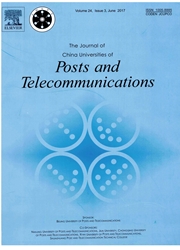

 中文摘要:
中文摘要:
新服务的出现要求多点传送在光网络的功能。因为高费用和复杂建筑学多点传送有能力(MC ) 节点,分享裂口的开关结构在轻 splitters 被所有输入信号在哪个分享被介绍。使适应这种状况,由扩大资源保留协议交通工程(RSVP-TE ) 和开的最短的路径第一交通的工程(OSPF-TE ) ,一新光多点传送机制被提供,发信号的流动和它的有限州的机器模型被给。同时,在分享裂口的光网络的一个 multicast 路由算法和到平衡网络交通的一条变化连接重量政策被建议。当 splitters 的数字是由传统的 MC 节点要求了那中的 25% 个时,在 NSFNET 表演的模拟不管与或没有波长变换器, multicast 表演接近了理想的情形。当 splitters 的数字是足够的时,波长变换器和变化连接重量在改进交通表演帮助大部分。
 英文摘要:
英文摘要:
The emergence of new services demands multicast function in optical network. Because of the high cost and complex architecture of multicast capable (MC) node, splitter- sharing switch structure is introduced in which the light splitters are shared by all input signals. To accommodate to this situation, by extending resource ReSerVation protocol-traffic engineering (RSVP-TE) and open shortest path first-traffic engineering (OSPF-TE), a new optical multicast mechanism is provided and the signaling flow and its finite state machine model are given. At the same time, a multicast routing algorithm in splitter-sharing optical network and a changing link weight policy to balance network traffic are proposed. Simulations in NSFNET show no matter with or without wavelength converters, when the number of splitters is 25% of that demanded by traditional MC nodes, the multicast performance has been close to the ideal circumstance. Wavelength converters and changing link weight help much in improving the traffic performance when the number of splitters is adequate.
 同期刊论文项目
同期刊论文项目
 同项目期刊论文
同项目期刊论文
 Performance of PCE-based Fast Routing Strategy in Large-scale Multi-layer Multi-domain Optical Netwo
Performance of PCE-based Fast Routing Strategy in Large-scale Multi-layer Multi-domain Optical Netwo Analytical Models of Blocking Probability for Multi-granularity Cross-connect Based Optical Networks
Analytical Models of Blocking Probability for Multi-granularity Cross-connect Based Optical Networks Dynamic Quality of Transmission Optimization and Global Impairments Control in Reconfigurable Transp
Dynamic Quality of Transmission Optimization and Global Impairments Control in Reconfigurable Transp Modeling and analysis of a hybrid optical switching system with delay buffer and wavelengths classif
Modeling and analysis of a hybrid optical switching system with delay buffer and wavelengths classif 期刊信息
期刊信息
